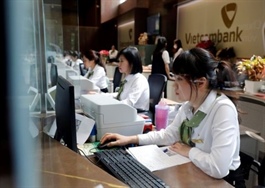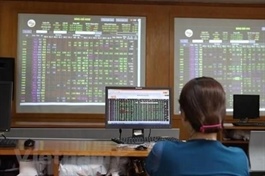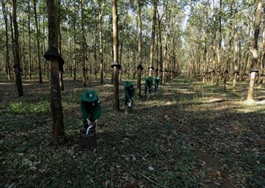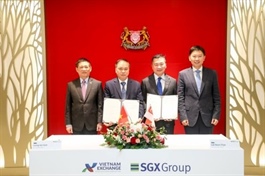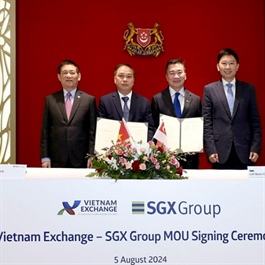Apparel, textile stocks shine with promise amid shifting order opportunities
Apparel, textile stocks shine with promise amid shifting order opportunities
Apparel and textile stocks experienced impressive performances in the last trading sessions, boosted by a positive outlook for the domestic garment industry amid crisis in Bangladesh.
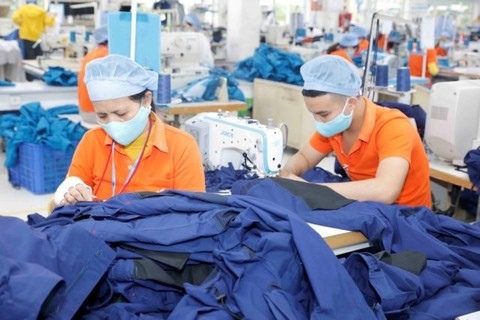
Workers making products for export at a plant of Việt Hưng Textile Garment Company. — VNA/VNS Photo |
In just two days, shares of Sông Hồng Garment JSC (MSH) soared 7.9 per cent, TNG Investment and Trading JSC (TNG) rose 5.6 per cent, Binh Thanh Import - Export Production & Trade JSC (GIL) jumped 3.2 per cent, Thành Công Textile Garment Investment Trading JSC (TCM) climbed nearly 2 per cent and Vinatex (VGT) surged 5 per cent.
The rally also spread to smaller-cap stocks, such as Việt Tiến Garment Corporation (VGG) increased 5 per cent, DamSan JSC (ADS) was up 7.3 per cent and GARCO 10 (M10) climbed 3.4 per cent.
The recent political turmoil in Bangladesh has served as a catalyst for this group of stocks to surge in the past few trading sessions.
Against a backdrop of escalating unrest, on August 5, the Bangladesh Garment Manufacturers and Exporters Association called for all factories in the country to cease operations until the situation stabilised.
By August 7, these manufacturing units had resumed operations as the situation was brought under control.
Bangladesh is currently the world's second-largest exporter of textiles and garments, trailing only behind China.
In 2023, Bangladesh's textile and garment exports hit US$47 billion. Prominent fashion brands such as Zara, H&M, Uniqlo and Carrefour among others, count Bangladesh among their suppliers.
Consequently, the adverse developments in Bangladesh are sparking global apprehension about potential disruptions in the supply chain, particularly during the critical phase of shipping Christmas merchandise and placing orders for the upcoming spring and summer seasons.
The primary concern lied in the diminishing trust of international buyers in Bangladesh, SM Mannan Kochi, Chairman of the Bangladesh Garment Manufacturers and Exporters Association, told the Sourcing Journal. The erosion of trust was deemed invaluable as it would inevitably have enduring adverse effects on the country's most valuable industry, he added.
Recognising Bangladesh as a formidable competitor, the Việt Nam Textile and Apparel Association (Vitas) foresees potential advantages for the country’s textile sector amid the challenges faced by Bangladesh.
In the immediate term, Bangladesh's textile production capacity is set to decline amid the peak season, currently catering to winter production. This is likely to prompt many clients to divert their orders elsewhere, including Việt Nam, to offset the shortages.
Waning customer confidence in Bangladesh's textile industry is expected, coupled with the looming pressure to raise wages for textile workers in the country, thereby diminishing Bangladesh's labour-cost advantage.
According to Vitas, many textile export businesses in Bangladesh are currently facing a 25 - 40 per cent drop in orders, alongside declining export prices. This is driven by reduced global demand, with imports from western Europe and Russia notably decreasing. Some companies, previously exporting over $1 million monthly to Russia, now see their exports at zero.
The opportunities for Việt Nam’s apparel exports is bright.
Even though, Bangladesh textiles are highly appreciated thanks to their environmentally friendly characteristic, sustainability is merely one of the 12 factors constituting competitive prowess, alongside criteria such as production quality, timely delivery, pricing, customs advantages and political stability, Nguyễn Minh Hoàng, Head of Analysis at First Việt Nam Securities, told Việt Nam News, citing The 2022 report 'Textiles and Clothing in Asian Graduating LDCs - Challenges and Options' by the World Trade Organization (WTO).
Việt Nam’s textile sector holds several unique advantages, including its strategic geographical location, extensive port infrastructure, and capacity to produce a wide array of high-value products, setting it apart from Bangladesh, which primarily focuses on basic T-shirt manufacturing, according to Hoàng.
The country’s strength lies in its ability to rapidly diversify production thanks to investments in advanced machinery and skilled labour, a notable advantage over Bangladesh.
Vietnamese textile enterprises poised for gains are those with the operational capacity to absorb newly redirected orders from the Bangladeshi market.
On the stock market, the expected improvement in export orders would be momentum for the apparel and textile ticker symbols, Hoàng said, adding that the export-import stock group has seen moderate growth since the start of the year, suggesting they are reasonably valued and aligning with the profit recovery cycle amid the ongoing economic resurgence.
Việt Nam’s textile export value has already seen a 3 per cent uptick in the first seven months of 2024. Across key markets, exports have displayed growth in the first half of 2024, with the US maintaining its position as a major market with an enhanced market share.










